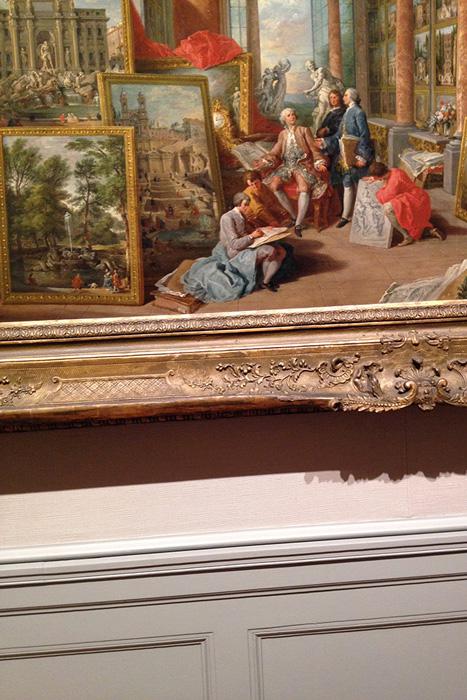Luis Jacob takes pictures of paintings. This act, a gauche transgression to some, became the basis for a smart, elegant recent show at Toronto’s Birch Libralato. Here, in addition to two large-format minimalist paintings, Jacob presented 26 iPhone screen–sized photographs of various pieces in art galleries and museums across the world, intuitively arranged in the gallery’s main space.
The project—like the artist’s 2011 Museum of Contemporary Canadian Art show “Pictures at an Exhibition,” which included work from his student days—is elliptically autobiographical. Jacob’s recent travels for international exhibitions have, seemingly, given birth to it. (At times, one can see Jacob’s reflection in the museum glass of the works he has captured.) It is useful, then, to begin by mentioning Jacob’s remarkable eye for detail. Few Canadian artists are as enthusiastic and personal about contemporary art history, or as concerned with the implications of looking, especially within institutional contexts.
The project, entitled Show Your Wound, will, to those familiar with Jacob’s work, recall another project, the ongoing collage-based Album series. The difference is that, for Show Your Wound, Jacob has photographed the works himself, and is not finding images of them in magazines. Indeed, for the most part, the fragments Jacob captures of museum paintings are not manipulated, and bear their taker’s original crop—presumably devised in the heat of the moment, under the watchful eye of guards. This newfound control is, then, still tempered by chance (and others’ gazes), including the way each image has eventually been paired with its neighbour, forming a narrative both formally specific yet thematically broad. In all, the series testifies to the magical function of the picture plane in art: a force limiting and limitless, mutilating and generative.
Another operative principle in Show Your Wound is what is effected by the phenomenon of ellipsis—a fundamental of optics, and thus of aesthetics. Form in art is necessarily restrictive: cuts are made to collage pieces and film sequences; photographs and paintings are defined by various framing devices. But this “wound,” when employed in art, turns absence into presence—a “show.” Cut-up images and text merge to form new fields of meaning; the frame pens in the eye, pulling it into the action of the painting or photograph. Christian Marclay’s The Clock comes to mind, wherein fragments of works, incorporated, become another work: a story of form. It should be mentioned that this wonderful capacity of ellipsis—of the mind to want to repair what is broken, or of the process of breaking leading to new, fascinating kinds of cohesion—is at the root of analog cinema, where 24 frames, sped up to fit into one second, give the illusion of fluid movement.
One’s eye thus moves forward across the images in Show Your Wound Muybridge-like, as if they are these frames. But Jacob manages to make associations both within and across each image. The first image is a detail of Picture Gallery with Views of Modern Rome by Giovanni Paolo Pannini at the Museum of Fine Arts in Boston, a work in which a duke and his assistants pore over and inventory paintings in embellished gilt frames. The painting itself is hung in a gilt frame, and Jacob’s foregrounding of this fact (with emphasis on the shadow thrown against the wall by the frame) suggests the acts of looking and itemization that underpin this series.
Yet as with The Clock, it’s not really about knowing where the bits come from—it’s about forgetting them and allowing oneself to travel across the bridges that, in their isolation and reconstitution, the bits create. Notably, Jacob has carefully juxtaposed contemporary minimalism with religious painting, showing us a powerful, natural alliance in their apparent dissimilarity: an interest in making the art object into a kind of visual vortex or epiphany. Juxtapositions include Joseph Beuys’s Untitled (from PLIGHT), one of its rolls of felt punctured by a long, thin yellow stick, and an early Renaissance deposition of Christ—the familiar figure also, of course, punctured and bleeding. A previous detail from Bernardo Strozzi’s The Incredulity of Saint Thomas, in London’s National Gallery, comes, in sequence, before this pairing. (One wonders if Jacob regretted not being able to find and photograph a Lucio Fontana cut canvas, which would have been a perfect fit for this series.) Later, a dripping Rothko leads into a bleeding stigmata, then into an N.E. Thing Co. photo of paint being poured into a hole, and then of a mater dolorosa bust in Vienna. The wound of the image is its mesmeric core, that Barthesian punctum: like Saint Thomas, the viewer probes it visually, wanting to believe. The probing itself creates novel, personal analyses, beyond the official control of the image. Meanings drip out. (The sexual connotations of Show Your Wound are, it need hardly be said, highly present and deliberate.)
Jacob ends his series with two Impressionist works: La Loge by Renoir at London’s Courtland Gallery and Toilette after the Bath by Degas at the New Carlsberg Glyptotek in Copenhagen. Here, as Camille Paglia reminds us in her new book Glittering Images, we can see the important influence of photographic cropping in Impressionism. There is a world outside the artwork, real as well as imaginary. Renoir’s opera-goer stares outside the frame with his theatre binoculars, his arm cut off; Degas’s bather is sawed in half, appearing to be both coming toward her maid and running out of the picture away from her. It’s an intelligent conclusion, full of Jacob’s gaze-fetishism—his layers of looking. The contemporary conceptualist photographs a painting that has a photographic basis. Both are acts of fragmentation, but both, through their encounter, make a new, beguiling thing.









